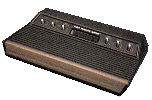Processors
Computer Systems
Software and Operating Systems
Graphics
Game Systems
Conclusion

Note: The less microns, the more transistors, and the more cycles, the hotter the
processor will be. For example, Intel's next planned development, the
300MHz
Pentium is
expected to produce 17 watts of excess heat energy. That's as much as a light
bulb!
 It was an 8 bit
microprocessor with a top speed of 8MHz, 29,000 transistors at a size of 3 microns
and could address 1 Meg of RAM (but no virtual memory). However, the 8086 paled in
comparison to Intel's 1982 release of the 286, which was quickly incorporated into
IBM's AT. The 286 processor had several key improvements over the previous processor.
The first is speed. It could run at 12 MHz top speed, with a 16 bit bus width. It
had 134,000 transistors (more than a quadruple improvement) an a size of 1.5 microns.
It could address 16 megabytes of RAM, 1 gigabyte of virtual memory, and had 6 times
the performance of the 8086. This opened the door for the 286 instruction set, which
is still used in programming to this day, as well as the AT architecture, which is also
still used. This innovation between IBM and Intel drastically changed the development
of computing.
It was an 8 bit
microprocessor with a top speed of 8MHz, 29,000 transistors at a size of 3 microns
and could address 1 Meg of RAM (but no virtual memory). However, the 8086 paled in
comparison to Intel's 1982 release of the 286, which was quickly incorporated into
IBM's AT. The 286 processor had several key improvements over the previous processor.
The first is speed. It could run at 12 MHz top speed, with a 16 bit bus width. It
had 134,000 transistors (more than a quadruple improvement) an a size of 1.5 microns.
It could address 16 megabytes of RAM, 1 gigabyte of virtual memory, and had 6 times
the performance of the 8086. This opened the door for the 286 instruction set, which
is still used in programming to this day, as well as the AT architecture, which is also
still used. This innovation between IBM and Intel drastically changed the development
of computing.
 As good as the 286 was, it would be surpassed 3 years later in 1985 by the 386. Intel
introduced the 386 on October 17, 1985 in a 16 MHz version. The 386 was an exciting
development because it was the first x86 processor to handle 32 bit data sets. Intel
shipped it in 16, 20, 25 and 33 MHz versions, and AMD shipped a 40 MHz version. The
chip held 275,000 transistors at a size of 1 micron. It could address 4 gigabytes of
RAM and 64 terabytes of virtual memory. The 386 opened the door to 32 bit computing.
It was at this point that Intel began encouraging software developers to design a
32-bit Operating System. Only recently has this really become popular with the
success of Windows 95 and Windows NT..
As good as the 286 was, it would be surpassed 3 years later in 1985 by the 386. Intel
introduced the 386 on October 17, 1985 in a 16 MHz version. The 386 was an exciting
development because it was the first x86 processor to handle 32 bit data sets. Intel
shipped it in 16, 20, 25 and 33 MHz versions, and AMD shipped a 40 MHz version. The
chip held 275,000 transistors at a size of 1 micron. It could address 4 gigabytes of
RAM and 64 terabytes of virtual memory. The 386 opened the door to 32 bit computing.
It was at this point that Intel began encouraging software developers to design a
32-bit Operating System. Only recently has this really become popular with the
success of Windows 95 and Windows NT..
 The final processor barely squeaked through into this article. The 486 DX was
introduced on April 10, 1989, in
a 25MHz version. It would later be released in versions of 33 MHz, 50 MHz and higher.
The 486 was the first chip to include a Level 1 cache on chip. The Level 1 cache
is an area on the chip of 16K that is used as RAM for frequently executed
instructions. It is
4-5 times faster than conventional RAM and reduces lag time between the memory and the
processor. It has 1.2 million transistors onboard at a size of .8 micron. It is
capable of addressing 4 gigabytes of RAM and 64 terabytes of virtual memory. It was
the 486 processor that made "point and click" computing a reality and GUIs such as
Windows truly possible.
The final processor barely squeaked through into this article. The 486 DX was
introduced on April 10, 1989, in
a 25MHz version. It would later be released in versions of 33 MHz, 50 MHz and higher.
The 486 was the first chip to include a Level 1 cache on chip. The Level 1 cache
is an area on the chip of 16K that is used as RAM for frequently executed
instructions. It is
4-5 times faster than conventional RAM and reduces lag time between the memory and the
processor. It has 1.2 million transistors onboard at a size of .8 micron. It is
capable of addressing 4 gigabytes of RAM and 64 terabytes of virtual memory. It was
the 486 processor that made "point and click" computing a reality and GUIs such as
Windows truly possible.


 lawsuit that Apple laid on Microsoft. The
lawsuit was based on the idea that Windows mimicked the "look and feel" of the
Macintosh. I find it very surprising that Apple felt they could do that...they stole
the basic idea for the Mac OS from a development team at XEROX PARC in Palo Alto, CA.
Now there's a tidbit I bet they'd like to hide...
lawsuit that Apple laid on Microsoft. The
lawsuit was based on the idea that Windows mimicked the "look and feel" of the
Macintosh. I find it very surprising that Apple felt they could do that...they stole
the basic idea for the Mac OS from a development team at XEROX PARC in Palo Alto, CA.
Now there's a tidbit I bet they'd like to hide...



Thanks to Corey for his input. Unauthorized reproduction of this
article is strictly prohibited. Logos used without permission. Sorry!
